General Information - Información General



[EN] The apartment building is part of a large scale public housing reconstruction project located about 15 minutes from Gifu City by car. Four women architects were selected under the coordination of Japanese architect Arata Isozaki to execute the projects. This L-shaped Wing designed by architect Kazuyo Sejima sits on the south-east part of the site where the idea for the overall layout of the development was to run the buildings around the perimeter.
[ES] El edificio de Apartamentos, es parte de un prozecto de reconstruccion de conjunto de habitacion Colectiva localisado a cerca de 15 minutos de la ciudad de Gifu (de coche) Cuatro Arquitectas han sido seleccionadas sob la coordinacion del Arquitecto Arata Isozaki, para la ejecution del proyecto. Esta ala en forma de L diseñado por el arquitecto Kazuyo Sejima se encuentra en la parte sur-este del lugar donde la idea de la disposición general del desarrollo era disponer los edificios alrededor del perímetro.
Design Concept and Principles - Concepto de Diseño y Principios

The Sejima Wing housing units has been designed with a relatively shallow depth. With such a depth, the ‘room’ becomes the only basic building block.

These blocks are combined in a variety of ways to produce a multitude of apartment plans and sections, thus generating complex elevations.
Each unit, consisting a few basic blocks, has provided with a courtyard-like terrace. The terraces create holes in the building through which the far side of the building can be glimpsed, thus reducing the visual impression of massiveness.
BODY



All rooms are equally lined up along the side receiving the most sun. These rooms are linked on the front by a narrow sunroom ("engawa"), which constitutes an intermediate space or buffer zone between interior and exterior. The silhouettes of people moving inside are visible on the south facade as on a screen.
BUILDING



Sejima: "Given that this building is made up of rental apartments, it could be assumed that various types of families would live in those units. In other words, we imagined that forms of
co-habitation would not be restricted to the existing standard family, but that different types of groupings of people should be considered..."
CITY

 South view - surrounding low-rise buildings
South view - surrounding low-rise buildings


In the project master plan, the courtyard lies between the four separate housing blocks designed byAkiko Takahashi, Kazuyo Sejima, Christine Hawley, and Elizabeth Diller. Because of the diversity of architectural design found within the project, strong site imagery and geometry have been created for the courtyard to unify the distinct parts of the project and to give the project a memorable identity.
ENVIRONMENT
(p.n. the building breads)
TECHNOLOGY


Modular Standardization
The use of ‘room’ as a modular building block is not difficult to understand in terms of standardization of major building components in any large scale housing development project. The basic principle of minimizing construction waste at the design level is achieved without doubt... Careful manipulation of spaces results in a variety of internal spatial configurations. Monotonous character has been dissolved and varieties generated while allowing the use of standardized components.
Mass Customization of Spaces
The generated complex spatial configurations and elevations result in more complicated design and construction process. Each floor and each room thus require additional efforts and attentions from the initial design stages to the management of construction works. Although repetitious design of units and buildings has often been argued as a sound practice in terms of efficiency and economy while generating less construction waste, it shall not limit the possibilities of how we design the environment for ourselves the construction possibilities. Mass customization of spaces and building forms in the context of standardization and waste management become a new challenge. New challenges however demand and encourage the industry’s innovation and ability to move forward.
IMPLEMENTATION
NEIGHBORS

Sejima: "Given that this building is made up of rental apartments, it could be assumed that various types of families would live in those units. In other words, we imagined that forms of
co-habitation would not be restricted to the existing standard family, but that different types of groupings of people should be considered..."
NEIGHBORHOOD
 Together with the other three buildings comprising the Gifu Kitagata Housing Project, a new closed neighborhood is created. Located on the seam between a low-rise neighborhood and an industrial area, this new block acts as an introverted neighborhood, with public spaces that are only for the use of its inhabit ans.
Together with the other three buildings comprising the Gifu Kitagata Housing Project, a new closed neighborhood is created. Located on the seam between a low-rise neighborhood and an industrial area, this new block acts as an introverted neighborhood, with public spaces that are only for the use of its inhabit ans.
General Information - Información General



[EN] The apartment building is part of a large scale public housing reconstruction project located about 15 minutes from Gifu City by car. Four women architects were selected under the coordination of Japanese architect Arata Isozaki to execute the projects. This L-shaped Wing designed by architect Kazuyo Sejima sits on the south-east part of the site where the idea for the overall layout of the development was to run the buildings around the perimeter.
[ES] El edificio de Apartamentos, es parte de un prozecto de reconstruccion de conjunto de habitacion Colectiva localisado a cerca de 15 minutos de la ciudad de Gifu (de coche) Cuatro Arquitectas han sido seleccionadas sob la coordinacion del Arquitecto Arata Isozaki, para la ejecution del proyecto. Esta ala en forma de L diseñado por el arquitecto Kazuyo Sejima se encuentra en la parte sur-este del lugar donde la idea de la disposición general del desarrollo era disponer los edificios alrededor del perímetro.
Design Concept and Principles - Concepto de Diseño y Principios

The Sejima Wing housing units has been designed with a relatively shallow depth. With such a depth, the ‘room’ becomes the only basic building block.

These blocks are combined in a variety of ways to produce a multitude of apartment plans and sections, thus generating complex elevations.
Each unit, consisting a few basic blocks, has provided with a courtyard-like terrace. The terraces create holes in the building through which the far side of the building can be glimpsed, thus reducing the visual impression of massiveness.
BODY



All rooms are equally lined up along the side receiving the most sun. These rooms are linked on the front by a narrow sunroom ("engawa"), which constitutes an intermediate space or buffer zone between interior and exterior. The silhouettes of people moving inside are visible on the south facade as on a screen.
BUILDING



Sejima: "Given that this building is made up of rental apartments, it could be assumed that various types of families would live in those units. In other words, we imagined that forms of
co-habitation would not be restricted to the existing standard family, but that different types of groupings of people should be considered..."
CITY

 South view - surrounding low-rise buildings
South view - surrounding low-rise buildings


In the project master plan, the courtyard lies between the four separate housing blocks designed byAkiko Takahashi, Kazuyo Sejima, Christine Hawley, and Elizabeth Diller. Because of the diversity of architectural design found within the project, strong site imagery and geometry have been created for the courtyard to unify the distinct parts of the project and to give the project a memorable identity.
ENVIRONMENT
(p.n. the building breads)
TECHNOLOGY


Modular Standardization
The use of ‘room’ as a modular building block is not difficult to understand in terms of standardization of major building components in any large scale housing development project. The basic principle of minimizing construction waste at the design level is achieved without doubt... Careful manipulation of spaces results in a variety of internal spatial configurations. Monotonous character has been dissolved and varieties generated while allowing the use of standardized components.
Mass Customization of Spaces
The generated complex spatial configurations and elevations result in more complicated design and construction process. Each floor and each room thus require additional efforts and attentions from the initial design stages to the management of construction works. Although repetitious design of units and buildings has often been argued as a sound practice in terms of efficiency and economy while generating less construction waste, it shall not limit the possibilities of how we design the environment for ourselves the construction possibilities. Mass customization of spaces and building forms in the context of standardization and waste management become a new challenge. New challenges however demand and encourage the industry’s innovation and ability to move forward.
IMPLEMENTATION
General Information - Información General



[EN] The apartment building is part of a large scale public housing reconstruction project located about 15 minutes from Gifu City by car. Four women architects were selected under the coordination of Japanese architect Arata Isozaki to execute the projects. This L-shaped Wing designed by architect Kazuyo Sejima sits on the south-east part of the site where the idea for the overall layout of the development was to run the buildings around the perimeter.
[ES] El edificio de Apartamentos, es parte de un prozecto de reconstruccion de conjunto de habitacion Colectiva localisado a cerca de 15 minutos de la ciudad de Gifu (de coche) Cuatro Arquitectas han sido seleccionadas sob la coordinacion del Arquitecto Arata Isozaki, para la ejecution del proyecto. Esta ala en forma de L diseñado por el arquitecto Kazuyo Sejima se encuentra en la parte sur-este del lugar donde la idea de la disposición general del desarrollo era disponer los edificios alrededor del perímetro.
Design Concept and Principles - Concepto de Diseño y Principios

The Sejima Wing housing units has been designed with a relatively shallow depth. With such a depth, the ‘room’ becomes the only basic building block.

These blocks are combined in a variety of ways to produce a multitude of apartment plans and sections, thus generating complex elevations.
Each unit, consisting a few basic blocks, has provided with a courtyard-like terrace. The terraces create holes in the building through which the far side of the building can be glimpsed, thus reducing the visual impression of massiveness.
BODY



All rooms are equally lined up along the side receiving the most sun. These rooms are linked on the front by a narrow sunroom ("engawa"), which constitutes an intermediate space or buffer zone between interior and exterior. The silhouettes of people moving inside are visible on the south facade as on a screen.
BUILDING



Sejima: "Given that this building is made up of rental apartments, it could be assumed that various types of families would live in those units. In other words, we imagined that forms of
co-habitation would not be restricted to the existing standard family, but that different types of groupings of people should be considered..."
CITY

 South view - surrounding low-rise buildings
South view - surrounding low-rise buildings


In the project master plan, the courtyard lies between the four separate housing blocks designed byAkiko Takahashi, Kazuyo Sejima, Christine Hawley, and Elizabeth Diller. Because of the diversity of architectural design found within the project, strong site imagery and geometry have been created for the courtyard to unify the distinct parts of the project and to give the project a memorable identity.
ENVIRONMENT



[EN] The apartment building is part of a large scale public housing reconstruction project located about 15 minutes from Gifu City by car. Four women architects were selected under the coordination of Japanese architect Arata Isozaki to execute the projects. This L-shaped Wing designed by architect Kazuyo Sejima sits on the south-east part of the site where the idea for the overall layout of the development was to run the buildings around the perimeter.
[ES] El edificio de Apartamentos, es parte de un prozecto de reconstruccion de conjunto de habitacion Colectiva localisado a cerca de 15 minutos de la ciudad de Gifu (de coche) Cuatro Arquitectas han sido seleccionadas sob la coordinacion del Arquitecto Arata Isozaki, para la ejecution del proyecto. Esta ala en forma de L diseñado por el arquitecto Kazuyo Sejima se encuentra en la parte sur-este del lugar donde la idea de la disposición general del desarrollo era disponer los edificios alrededor del perímetro.
Design Concept and Principles - Concepto de Diseño y Principios

The Sejima Wing housing units has been designed with a relatively shallow depth. With such a depth, the ‘room’ becomes the only basic building block.

These blocks are combined in a variety of ways to produce a multitude of apartment plans and sections, thus generating complex elevations.
Each unit, consisting a few basic blocks, has provided with a courtyard-like terrace. The terraces create holes in the building through which the far side of the building can be glimpsed, thus reducing the visual impression of massiveness.
BODY



All rooms are equally lined up along the side receiving the most sun. These rooms are linked on the front by a narrow sunroom ("engawa"), which constitutes an intermediate space or buffer zone between interior and exterior. The silhouettes of people moving inside are visible on the south facade as on a screen.

The Sejima Wing housing units has been designed with a relatively shallow depth. With such a depth, the ‘room’ becomes the only basic building block.

These blocks are combined in a variety of ways to produce a multitude of apartment plans and sections, thus generating complex elevations.
Each unit, consisting a few basic blocks, has provided with a courtyard-like terrace. The terraces create holes in the building through which the far side of the building can be glimpsed, thus reducing the visual impression of massiveness.



All rooms are equally lined up along the side receiving the most sun. These rooms are linked on the front by a narrow sunroom ("engawa"), which constitutes an intermediate space or buffer zone between interior and exterior. The silhouettes of people moving inside are visible on the south facade as on a screen.
BUILDING



Sejima: "Given that this building is made up of rental apartments, it could be assumed that various types of families would live in those units. In other words, we imagined that forms of
co-habitation would not be restricted to the existing standard family, but that different types of groupings of people should be considered..."

 South view - surrounding low-rise buildings
South view - surrounding low-rise buildings

In the project master plan, the courtyard lies between the four separate housing blocks designed byAkiko Takahashi, Kazuyo Sejima, Christine Hawley, and Elizabeth Diller. Because of the diversity of architectural design found within the project, strong site imagery and geometry have been created for the courtyard to unify the distinct parts of the project and to give the project a memorable identity.
(p.n. the building breads)
TECHNOLOGY


Modular Standardization
The use of ‘room’ as a modular building block is not difficult to understand in terms of standardization of major building components in any large scale housing development project. The basic principle of minimizing construction waste at the design level is achieved without doubt... Careful manipulation of spaces results in a variety of internal spatial configurations. Monotonous character has been dissolved and varieties generated while allowing the use of standardized components.
Mass Customization of Spaces
The generated complex spatial configurations and elevations result in more complicated design and construction process. Each floor and each room thus require additional efforts and attentions from the initial design stages to the management of construction works. Although repetitious design of units and buildings has often been argued as a sound practice in terms of efficiency and economy while generating less construction waste, it shall not limit the possibilities of how we design the environment for ourselves the construction possibilities. Mass customization of spaces and building forms in the context of standardization and waste management become a new challenge. New challenges however demand and encourage the industry’s innovation and ability to move forward.
NEIGHBORS

Sejima: "Given that this building is made up of rental apartments, it could be assumed that various types of families would live in those units. In other words, we imagined that forms of
co-habitation would not be restricted to the existing standard family, but that different types of groupings of people should be considered..."
co-habitation would not be restricted to the existing standard family, but that different types of groupings of people should be considered..."
 Together with the other three buildings comprising the Gifu Kitagata Housing Project, a new closed neighborhood is created. Located on the seam between a low-rise neighborhood and an industrial area, this new block acts as an introverted neighborhood, with public spaces that are only for the use of its inhabit ans.
Together with the other three buildings comprising the Gifu Kitagata Housing Project, a new closed neighborhood is created. Located on the seam between a low-rise neighborhood and an industrial area, this new block acts as an introverted neighborhood, with public spaces that are only for the use of its inhabit ans.NEIGHBORING

Minimal space is dedicated to public use: on every floor a long corridor is used both as the excess way to the apartments and as an open public balcony. Each apartment has a semi-private terrace that can be freely accessed from the main public corridor.
source


Ubicación: Gifu, japon
Materialidad: Hormigón armado
Altura: 10 pisos sin ascensor.
construcción 1994- marzo1998
Área base del edificio: 548m2
Total Área habitable: 4706m2
Arquitectos: Kazujo Zejima y Yamasei Sekkei
APROXIMACIÓN:
Este edificio de departamentos tipo block es parte de un proyecto a gran escala de reconstrucción de viviendas sociales en a las afueras de la ciudad de Gifu en Japon. queda a 20 minutos en auto de la ciudad. Fue un proyecto llamado a concurso donde se escogieron los proyectos de 4 Arquitectas japonesas bajo la dirección ejecutiva del arquitecto Arata Isozaki.
El proyecto llamado Kitagata fue diseñado por la Arquitecta Kazujo Sejima está en el lado sureste del sitio, la idea general del desarrollo del proyecto fue emplazar los edificios en el perímetro del terreno para poder dejar áreas de parque en el interior, de esto nace la forma en doble L del edificio. de base angosta en planta la forma se genera desde estas dos "eles" que se quiebran.


SOBRE LA FORMA
el conjunto habitacional de Sejima ha sido diseñado con mucha simpleza donde la única unidad que construye el conjunto tipo block es el departamento, no son dos o mas bloques es solo uno que en sus quiebres hace aparecer el lado opuesto como lo otro que contituiría un conjunto de esta tipologia.
Los departamentos son de planta standar, sin embargo se fueron combinando de distintas formas para construir tanto en elevación como en planta una secuencia aleatoria que le quitara monotonidad al edificio, problema frecuente en los edificios en altura. los espacios de circulacion publica son escaleras que se adosan a la estructura por la fachada del edificio y recorren el edificio en todo su largo como se puede observar en las imagenes a continuación.

Todos los pisos y cada cierto tramo están provisto de una suerte de terraza patio que van de un lado a lado, estos vanos se hacen notorios desde lejos dotando de cierta tralucidez al edificio, lo que hace que una estructura tan grande y densa como suele ser un edificio block, tenga un aspecto mas diáfano y menos invacivo con el entorno.

en esta imagen se pueden observar los vanos conectados con los espacios de circulación.
source
Los apartamentos Gifu Kitagata forman parte de un proyecto de vivienda social cerca de la ciudad de Gifu. El proyecto de SANAA se adapta a la parcela creando una forma que consigue generar mayor número de viviendas que una pieza longitudinal, dejando espacios libres en su interior.
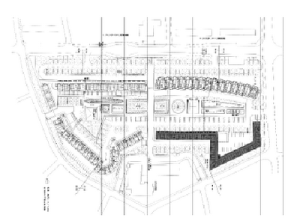
El volumen es simple y muy estrecho y su fachada va variando con sucesivos huecos. Aparentemente se trata de un volumen muy uniforme, sin embargo, existen muchos tipos diferentes de viviendas formadas por la suma de “pixeles”. Así existirá en todas las viviendas una sala de té, una terraza, un comedor y un cierto número de dormitorios dependiendo del tamaño de la vivienda.
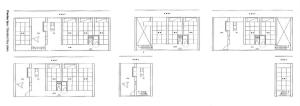
Todos los diferentes tipos de viviendas se encuentran perfectamente encajadas en la fachada como si de un tetrix se tratara quedando como huecos las terrazas de cada vivienda. Las terrazas dan al corredor común, luego son la unión con lo público. En la vivienda, todas las habitaciones dan a un corredor privado, engawa, que recibe toda la luz y por el cual se conectan. Luego en planta la composición es simple, dos corredores, uno público y uno privado con los píxeles entre ellos.
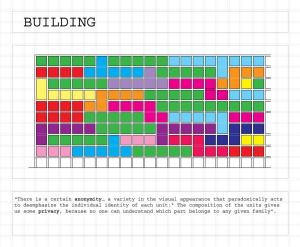
Debido a la estrecha crujía y a la continuidad de los módulos casi cuadrados, las comunicaciones, no se realizan entre las viviendas. En cambio, se sacan del edificio a través de unas escaleras que le dan dinamismo a la fachada por el lado público y van llegando a los corredores públicos asistiendo a todos los apartamentos desde una distancia razonable.
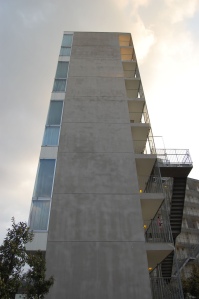
La idea del píxel es también una ayuda económica a la hora de construir. Los módulos habitacionales se estandarizan, consiguiendo que la mayoría de la obra pueda ser prefabricada.
Este proyecto, utiliza el módulo como unidad habitacional, compositiva y constructiva y así consigue múltiples variaciones en una fachada aparentemente continua y un bajo costo para la vivienda social.
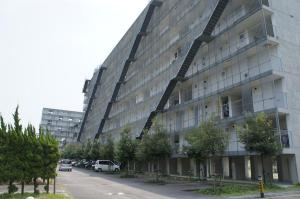
The Gifu Kitagata apartments are part of an urban plan of new social dwellings near the city of Gifu. SANAA proposes a single volume whose geometry is adapted to the site in a way that generates a higher amount of apartments that if it were a simple longitudinal volume.

The building is very simple and narrow and its facade varies due to several random openings. Apparently, it would seem as a very homogeneous volume, nevertheless, there are many different types of apartments composed by the addition of “pixels”. In every one of the apartments there will be a tearoom, a terrace, a dining room and the amount of bedrooms necessary.
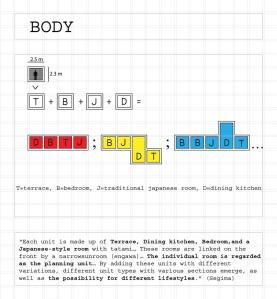
All the different sizes of apartments are perfectly meshed in the facade as a tetrix and the before random voids, are the terraces each of them possess. These terraces will be the connexion with the public corridor. Inside the apartments, all the rooms are connected through a private corridor, engawa, and receive the direct sunlight from it. As a result, the plan composition will turn out very simple, two corridors, the private and the public with several pixels in between them.
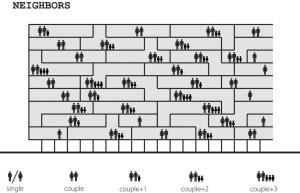

Owe to the narrowness of the building and the continuity of the square modules, the communications are not inside the volume. Instead, they are brought out of the building as long stairs, which provide dynamism to the public facade and assist all apartments in a short distance through the corridors.
The pixel idea is also convenient in construction matters. The modules are standardized and most of the construction is prefabricated which lowers the cost significantly.
This project uses a module as a strategy, which is at the same time constructive and compositional and so it develops a lot of variation in a apparently continuous facade with a relatively low cost for a social dwelling.
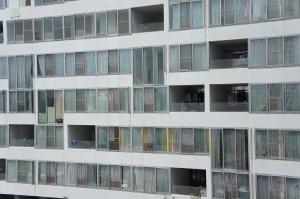
Departamentos Gifu Kitagata
De Casiopea
tipología/block


Ubicación: Gifu, japon
Materialidad: Hormigón armado
Altura: 10 pisos sin ascensor.
construcción 1994- marzo1998
Área base del edificio: 548m2
Total Área habitable: 4706m2
Arquitectos: Kazujo Zejima y Yamasei Sekkei
APROXIMACIÓN:
Este edificio de departamentos tipo block es parte de un proyecto a gran escala de reconstrucción de viviendas sociales en a las afueras de la ciudad de Gifu en Japon. queda a 20 minutos en auto de la ciudad. Fue un proyecto llamado a concurso donde se escogieron los proyectos de 4 Arquitectas japonesas bajo la dirección ejecutiva del arquitecto Arata Isozaki.
El proyecto llamado Kitagata fue diseñado por la Arquitecta Kazujo Sejima está en el lado sureste del sitio, la idea general del desarrollo del proyecto fue emplazar los edificios en el perímetro del terreno para poder dejar áreas de parque en el interior, de esto nace la forma en doble L del edificio. de base angosta en planta la forma se genera desde estas dos "eles" que se quiebran.


SOBRE LA FORMA
el conjunto habitacional de Sejima ha sido diseñado con mucha simpleza donde la única unidad que construye el conjunto tipo block es el departamento, no son dos o mas bloques es solo uno que en sus quiebres hace aparecer el lado opuesto como lo otro que contituiría un conjunto de esta tipologia.
Los departamentos son de planta standar, sin embargo se fueron combinando de distintas formas para construir tanto en elevación como en planta una secuencia aleatoria que le quitara monotonidad al edificio, problema frecuente en los edificios en altura. los espacios de circulacion publica son escaleras que se adosan a la estructura por la fachada del edificio y recorren el edificio en todo su largo como se puede observar en las imagenes a continuación.

Todos los pisos y cada cierto tramo están provisto de una suerte de terraza patio que van de un lado a lado, estos vanos se hacen notorios desde lejos dotando de cierta tralucidez al edificio, lo que hace que una estructura tan grande y densa como suele ser un edificio block, tenga un aspecto mas diáfano y menos invacivo con el entorno.

en esta imagen se pueden observar los vanos conectados con los espacios de circulación.
source
Los apartamentos Gifu Kitagata forman parte de un proyecto de vivienda social cerca de la ciudad de Gifu. El proyecto de SANAA se adapta a la parcela creando una forma que consigue generar mayor número de viviendas que una pieza longitudinal, dejando espacios libres en su interior.

El volumen es simple y muy estrecho y su fachada va variando con sucesivos huecos. Aparentemente se trata de un volumen muy uniforme, sin embargo, existen muchos tipos diferentes de viviendas formadas por la suma de “pixeles”. Así existirá en todas las viviendas una sala de té, una terraza, un comedor y un cierto número de dormitorios dependiendo del tamaño de la vivienda.

Todos los diferentes tipos de viviendas se encuentran perfectamente encajadas en la fachada como si de un tetrix se tratara quedando como huecos las terrazas de cada vivienda. Las terrazas dan al corredor común, luego son la unión con lo público. En la vivienda, todas las habitaciones dan a un corredor privado, engawa, que recibe toda la luz y por el cual se conectan. Luego en planta la composición es simple, dos corredores, uno público y uno privado con los píxeles entre ellos.

Debido a la estrecha crujía y a la continuidad de los módulos casi cuadrados, las comunicaciones, no se realizan entre las viviendas. En cambio, se sacan del edificio a través de unas escaleras que le dan dinamismo a la fachada por el lado público y van llegando a los corredores públicos asistiendo a todos los apartamentos desde una distancia razonable.

La idea del píxel es también una ayuda económica a la hora de construir. Los módulos habitacionales se estandarizan, consiguiendo que la mayoría de la obra pueda ser prefabricada.
Este proyecto, utiliza el módulo como unidad habitacional, compositiva y constructiva y así consigue múltiples variaciones en una fachada aparentemente continua y un bajo costo para la vivienda social.

The Gifu Kitagata apartments are part of an urban plan of new social dwellings near the city of Gifu. SANAA proposes a single volume whose geometry is adapted to the site in a way that generates a higher amount of apartments that if it were a simple longitudinal volume.

The building is very simple and narrow and its facade varies due to several random openings. Apparently, it would seem as a very homogeneous volume, nevertheless, there are many different types of apartments composed by the addition of “pixels”. In every one of the apartments there will be a tearoom, a terrace, a dining room and the amount of bedrooms necessary.

All the different sizes of apartments are perfectly meshed in the facade as a tetrix and the before random voids, are the terraces each of them possess. These terraces will be the connexion with the public corridor. Inside the apartments, all the rooms are connected through a private corridor, engawa, and receive the direct sunlight from it. As a result, the plan composition will turn out very simple, two corridors, the private and the public with several pixels in between them.


Owe to the narrowness of the building and the continuity of the square modules, the communications are not inside the volume. Instead, they are brought out of the building as long stairs, which provide dynamism to the public facade and assist all apartments in a short distance through the corridors.
The pixel idea is also convenient in construction matters. The modules are standardized and most of the construction is prefabricated which lowers the cost significantly.
This project uses a module as a strategy, which is at the same time constructive and compositional and so it develops a lot of variation in a apparently continuous facade with a relatively low cost for a social dwelling.






